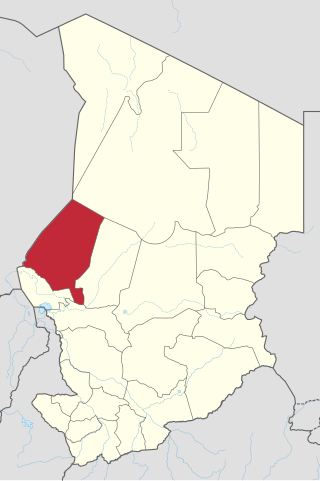Wadi Bissam | |
|---|---|
| Country | |
Wadi Bissam is a department of Kanem Region in Chad. It was created by Order No. 002 / PR / 08 of 19 February 2008. [1] Its chief town is Mondo. [2] [3]
Wadi Bissam | |
|---|---|
| Country | |
Wadi Bissam is a department of Kanem Region in Chad. It was created by Order No. 002 / PR / 08 of 19 February 2008. [1] Its chief town is Mondo. [2] [3]
The Wadi Bissam department is divided into 2 sub-prefectures:
List of administrators :
The Republic of Chad is divided into 23 regions.
Bahr el Gazel was formerly a department in the Kanem Region of Chad.

Wadi Fira is one of the 23 regions of Chad. Its capital is the town of Biltine. The region corresponds with the former prefecture of Biltine.

Kanem is one of the 23 regions of Chad. It is named after the famous Kanem Empire, which was centred in this vicinity. The region's capital is Mao. It was created in 2002 from the former Prefecture of Kanem. In 2008, a portion of the Kanem region was split off to become the new Bahr el Gazel Region.

The regions of Chad are divided into 61 departments. The departments are listed below, by name and by region.

Batha is one of the 23 regions of Chad, located in the centre of the country. It is composed of what was formerly Batha Prefecture with some slight boundary adjustments. The capital of the region is Ati.

Ouaddaï or Wadai is a region of Chad, located in the south-east of the country, with its capital at Abéché. Prior to 2002 it was known as Ouaddaï Prefecture; in 2008 the southern portions of Ouaddaï were split off to become the new Sila Region.
Borkou is one of two departments of the Borkou Region in Chad. It was established by Ordinance No. 002/PR/08 of 19 February 2008. Its capital is Faya-Largeau.

The departments of Chad are divided into 348 sub-prefectures (sous-préfectures).

Barh El Gazel is one of the 23 regions of Chad. The region's name may also be written as Barh El Gazal or Bahr el Gazel. Its capital is the town of Moussoro. The region was created in 2008 from the former Barh El Gazel Department of the Kanem Region.
Borkou Yala is a department of Borkou Region in Chad. It was created by Order No. 002 / PR / 08 of 19 February 2008. Its chief town is Kirdimi.
Guéni is a department of Logone Occidental Region in Chad. Its chief town is Krim Krim.
Kimiti is a department of Sila Region in Chad. Its chief town is Goz Beida.
Kouh-Est is a departments of Logone Oriental Region in Chad. Its chief town is Bodo.
Kouh-Ouest is a departments of Logone Oriental Region in Chad. Its chief town is Béboto.
Mangalmé is a department of Guéra Region in Chad. Its chief town is Mangalmé.
Nord Kanem is a department of Kanem Region in Chad. It was created by Ordinance No. 002 / PR / 08, on February 19, 2008. Its capital is Nokou.
Tibesti Est is a department of Tibesti Region in Chad. It was created by Ordinance No. 002 / PR / 08 of 19 February 2008. Its chief town is Bardai.
Tibesti Ouest is a department of Tibesti Region in Chad. It was created by Ordinance No. 002 / PR / 08 of 19 February 2008. Its seat is Zouar
Wadi Hawar is a department in the Ennedi-Est region of the Republic of Chad.